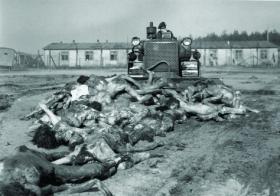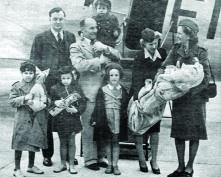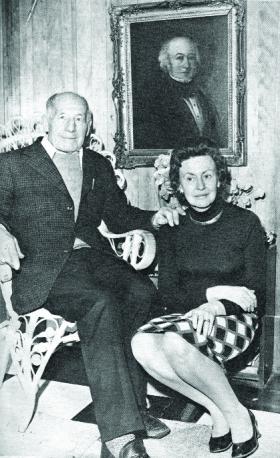Bob Collis: ‘the Irish Schindler’
Published in 20th-century / Contemporary History, Issue 6 (Nov/Dec 2006), News, Volume 14
When the British Army and Red Cross liberated Belsen they were faced with the task of clearing away 60,000 corpses. Collis wrote a book detailing his Belsen experiences. (Imperial War Museum)
Bob Collis was the son of William, a lawyer who had been born without property, despite coming from a line of landed Anglo-Irish gentry and medical professionals, but who by stern economy had made enough money to purchase a sizeable portion of Killiney Hill, just south of Dublin. William Collis was a staunch exponent of the superannuated notions of social hierarchy and Victorian self-denial, and his son grew up both deeply influenced by these ideas and determined to shake them off. Bob Collis’s decision to follow his forebears into medicine, therefore, was motivated not by hopes of social standing or material advantage but by a desire to ‘battle against the pain and cruelty of the world’.
After an undistinguished academic career at Rugby, Collis spent a somewhat more successful period at Cambridge and Yale. He qualified as a paediatrician at King’s College Hospital in London’s East End, with residencies in various parts of England and America, and a brief stint at Dublin’s Rotunda Hospital. While he was working in the Rotunda, he also notched up a few caps for the Irish rugby team. A period of research at the Johns Hopkins Hospital in Baltimore, USA, and the Great Ormond Street Hospital for Sick Children, London, confirmed his love of new scientific thought.
Returning to a post-Civil War Ireland, Collis found himself baffled by a society still deeply divided by political strife and social inequality. The paediatrics establishments in the Rotunda and the National Children’s Hospital were antiquated in their thought and methods. Collis set about organising ‘real paediatrics’ in Dublin and developed a new neonatal department at the Rotunda.
During the Second World War, however, as the real cruelty of Hitler’s Nazi regime became apparent, Collis found a cause to which he could devote both his medical skill and his sense of adventure. He joined the International Red Cross in 1945 and set off for Holland. Finding himself of little use in a territory already well equipped with medical personnel, he took a convoy to the newly liberated concentration camp of Bergen-Belsen, near Hanover in northern Germany. There he found a desperate need for his expertise:

Bob Collis carries one of the Belsen orphans on his shoulder as he arrives with them at Dublin Airport, 1946. (Zoltan Zinn-Collis)
‘The inmates of the camp had been starved during the last winter and now their malnutrition was accentuated by an epidemic of typhus carried by lice, and every form of enteritis including typhoid fever was rife . . . they had been dying at the rate of a thousand a day when the camp was opened by the British Army. Any help our Irish doctors could bring would be more than welcome.’
Collis began to help with the evacuation of the sick from the overcrowded barracks, and then took charge of a makeshift children’s hospital. At first there was little he or the other doctors could do, starvation and disease being too far advanced in many of his patients, and prisoners continued to die in their thousands. In the weeks and months that followed the liberation, however, those who managed to survive began to recover.
Among the children in Collis’s care were Zoltan Zinn and his sister Edit, who had been taken from their home in rural Slovakia to Ravensbrück, where their father had been murdered, and then to Belsen. They were the only remaining members of their family, their mother having died on the day of liberation and their brother shortly afterwards. When the time came for repatriation, Zoltan, Edit and three other children were the only ones for whom no home or family could be found. It fell to Collis to settle their fate, and he decided that these children would accompany him to Ireland.
The children were sent to Sweden for a period of convalescence, during which time Collis and his Dutch nurse Han Hogerzeil, with whom he had begun an affair in Belsen, returned to Germany for the Lüneburg trials, which saw the commandant of Belsen and numerous SS guards sentenced to death for their part in the ‘Final Solution’. Han then went to New York and London to work for the United Nations, while Collis and the children finally flew to Ireland in late 1946. Jewish families were found for the other three children, but Collis decided that Zoltan and Edit would live with him, his wife and two sons.
Collis plunged himself back into his medical life, which included work in the sorely deprived residential suburbs of Dublin. During the course of this work he met and became friends with Christy Brown. Collis, who had already written several plays as well as a book detailing his Belsen experiences, tutored Christy Brown in the techniques of prose and edited the manuscript that would become My left foot.

With Han Hogerzeil, a Dutch nurse whom Collis met on his journey to Belsen and with whom he had a lifelong affair. The couple retired to the Wicklow Mountains in the 1970s. (Zoltan Zinn-Collis)
When his own children had grown up, Collis finally divorced his wife Phyllis and married Han, who had just given birth to his child, Seán. Having been introduced to and greatly struck by Abubakar Tafawa Balewa, a minister in the newly formed Nigerian government (and later its prime minister), he accepted a job as director of the new Paediatric Department at Ibadan, where he found himself facing, almost alone, an extreme struggle against malnutrition. He proposed the establishment of an Institute of Child Health for Nigeria and began research into malnutrition, becoming head of the Institute and subsequently Professor of Child Health in the Lagos Medical School, and known worldwide as a leading paediatric nutritionist. In this capacity Collis travelled all over Africa during the following years.
Seán’s death in an accident at the age of 13 devastated both Collis and Han, and they wound up their African concerns and returned to Ireland and retirement in the Wicklow mountains. Some years later, Collis died after falling from his horse on his way home.
His adopted son Zoltan remembers Collis’s life as a public one, with perhaps a corresponding lack in the private sphere:
‘He was like Francis Drake or Walter Raleigh—an adventurer. Great on an open sea with the wind in his hair; less great in the small pond of family life.’
It was perhaps this very outward-mindedness, however, coupled with a Victorian moral certitude brazen enough to emerge unaffected from Nazi atrocity, Irish cultural strife and African poverty, that enabled Bob Collis to make his considerable contribution to history.
Alicia McAuley is co-author of Final witness: my journey from the Holocaust to Ireland (Maverick House, Dublin, 2006).
Bob Collis: ‘the Irish Schindler’
Alicia McAuley outlines the career of Bob Collis, who contributed hugely to Irish and African medicine, as well as being one of the few genuine Irish heroes of the Second World War
















